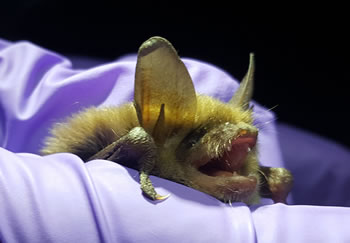  |
Bat Conservation in Summer |
|
|
Much of NJ's bat conservation work takes place in the summer, when all 9 bat species are active across the landscape. In 2017, NJ joined the North American Bat Monitoring Program (NABat) and re-booted our statewide acoustic surveillance program for long-term population monitoring. Surveys are done annually within 12 randomly chosen grid cells (10 km x 10 km square), each containing one driving transect and two stationary survey points. Acoustic bat detectors (Pettersson D500x model) are used to record the high-frequency echolocation calls that bats give off as they navigate and forage through the night skies. Since different bat species have unique call patterns, acoustic detection is a great tool for documenting the abundance and diversity of bats in an area of interest. The long-term NABat program will help us track populations over time.
Since the Northern long-eared bat (Myotis septentrionalis) gained federal protection as a Threatened species in 2015, we've been working to better understand the distribution and habitat needs of this once-common but under-surveyed species in order to best direct our conservation efforts and regulations. Northern long-eared bats are particularly elusive and difficult to survey. They're scarce throughout our forests and roost in a variety of obscure places. They fly amongst the clutter of tree branches and forage over small stream corridors rather than out in the open, making them difficult to catch by net or to record with an acoustic detector. To learn more on the whereabouts of this species across NJ, the ENSP has partnered with the Conserve Wildlife Foundation of NJ, Rutgers University, William Paterson University, Centenary University, and others to conduct mist-netting and radio-telemetry surveys during the summer. Locating Northern long-eared bats, their colonies, and their roost trees will enable us to better conserve these bats on state-managed lands as well as protect their most important life-stages via the federal 4(d) rule.
|

An adult female Northern long-eared bat caught and radio-tracked in Ocean County, summer 2016.
Click to enlarge |
We have also recently begun survey efforts for the under-studied Eastern small-footed bat (Myotis leibii), which roost in rocky areas like talus slopes, boulder fields, and cliff faces. Visual transect searches have had good success in western Virginia (Huth et al. 2015) but have not been as encouraging yet in NJ. Acoustics have given us many positive hits for the species that will help guide later mist-netting and visual survey efforts. Eastern small-footed bats are among those affected by White-nose Syndrome, though far less so than other closely related species like the Little brown (M. lucifugus), Northern long-eared bat (M. septentrionalis), or Indiana bat (M. sodalis).
Our longer-running maternity colony surveys, done in partnership with the Conserve Wildlife Foundation's Summer Bat Count, have given us a few summertime insights on the impact of White-nose Syndrome on our two common "house bat" species - the Little brown and Big brown bats. First, Big browns do not appear to have suffered any population declines in NJ, while Little browns have dropped by more than 90% at their summer roosts. In fact, Big brown bats may have increased by nearly 20% since the arrival of White-nose Syndrome, likely owed to the "competitive release" of resources following the Little browns' collapse. But now, several years after initial infection, adult female Little browns appear to be reproducing at healthy levels again, with some female pups returning to the roost in future years to raise pups of their own. And the wing scars from early WNS damage have faded to the point of being nearly invisible. Some of the bats we've banded at their summer roosts have turned up during winter surveys in and outside of NJ, as far as 100 miles away. These are a few hopeful signs.
Continue on to Bats In Buildings
Back to Bat Conservation
|

